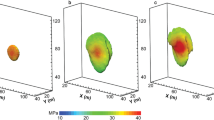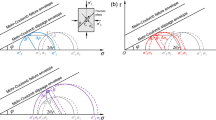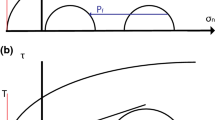Abstract
The spatio–temporal evolution of fluid-injection-induced seismicity is often bounded by a triggering front that expands away from the injection point in space and time. For some injection scenarios, the triggering front is thought to be directly linked to pore pressure diffusion, but in the case of hydraulic fracturing, the stress interaction of the growing tensile fracture with natural joints may be more significant. In order to explore the concept of a triggering front in this context, we use a fully coupled hydro–mechanical finite-discrete element (FDEM) approach to simulate microseismicity induced by hydraulic fracture growth. The medium contains a network of randomly oriented pre-existing fractures that are activated based on the Mohr–Coulomb failure criterion. As expected, the primary triggering front is defined by the envelope of microseismicity that tracks the hydraulic fracture, although more distal events are triggered by mechanical stress changes beyond the bounds of the triggering front. However, these distal events are approximately synchronous with initiation of the hydraulic fracture and are attributed to far-field elastic perturbations associated with the stress wave spread in the medium. A field example indicates that patterns of seismicity that emerge from our simulations have characteristics similar to observed microseismicity during hydraulic fracturing.







Similar content being viewed by others
Notes
The global behavior of material undergoing loading is elastic; however, non-linear means that the size of the plastic zone at the fracture tip changes as the fracture grows or as loads change, which is the common case of brittle materials.
Capturing the magnitude range of the numerical-induced seismic events is not the focus of our study (interested readers can refer to AbuAisha et al. (2017)).
References
AbuAisha M, Eaton D, Priest J, Wong R (2017) Hydro-mechanically coupled FDEM framework to investigate near–wellbore hydraulic fracturing in homogeneous and fractured rock formations. J Pet Sci Eng 154:100–113
AbuAisha M, Loret B, Eaton D (2016) Enhanced geothermal systems (EGS): hydraulic fracturing in a thermo–poroelastic framework. J Pet Sci Eng 146:1179–1191
AbuAisha M, Loret B (2016a) Influence of hydraulic fracturing on impedance and efficiency of thermal recovery from HDR reservoirs. Geomechanics Energy Environ 7:10–25
AbuAisha M, Loret B (2016b) Stabilization of forced heat convection: applications to enhanced geothermal systems (EGS). Transp Porous Media 112:229–252
Adachi J, Siebrits E, Peirce A, Desroches J (2007) Computer simulation of hydraulic fractures. Int J Rock Mech Min Sci 44:739–757
Barenblatt GI (1962) The mathematical theory of equilibrium cracks in brittle fracture. Adv Appl Mech 7:55–129
Boroumand N (2015) Energy–based hydraulic fracture numerical simulation: parameter selection and model validation using microseismicity. Geophysics. https://doi.org/10.1190/geo2014-0091.1
Bruel D (2007) Using the migration of the induced seismicity as a constraint for fractured Hot Dry Rock reservoir modelling. Int J Rock Mech Min Sci 44:1106–1117
Chou Q, Gao J, Somerwil M (2011) Analysis of geomechanical data for Horn River basin gas shales, NE British Columbia, Canada. In: The SPE Middle East unconventional gas conference and exhibition, Paper SPE 142498, Muscat, Oman, 31 January – 2 February
Cipolla LC, Williams JM, Weng X, Mack M, Maxwell S (2010) Hydraulic fracture monitoring to reservoir simulation: maximizing value. In: The SPE Annual Technical Conference and Exhibition, Paper SPE 133877, Florence, Italy, 19–22 September
Cornet F (2000) Comment on ‘Large-scale in situ permeability tensor of rocks from induced microseismicity’ by S. A. Shapiro, P. Audigane and J.-J. Royer. Geophys J Int 140:465–469
Dinske C, Shapiro SA, Rutledge JT (2010) Interpretation of microseismicity resulting from gel and water fracturing of tight gas reservoirs. Pure Appl Geophys 167:169–182
Damjanac B, Cundall P (2016) Application of distinct element methods to simulation of hydraulic fracturing in naturally fractured reservoirs. Comput Geotech 71:283–294
Duan K, Kwok CY, Wu W, Jing L (2018) DEM modeling of hydraulic fracturing in permeable rock: influence of viscosity, injection rate and in situ states. Acta Geotechnica. https://doi.org/10.1007/s11440-018-0627-8
Eaton DW (2018) Passive seismic monitoring of induced seismicity: fundamental principles and application to energy technologies. Cambridge University Press
Eaton D, Davidsen J, Pedersen KP, Boroumand N (2014) Breakdown of the Gutenberg–Richter relation for microearthquakes induced by hydraulic fracturing: influence of stratabound fractures. Geophys Prospect 62(4):806–818
Economides JM, Nolte GK (2003) Reservoir stimulation. Wiley, 3rd edition
Fjaer E, Holt RM, Horsrud P, Raaen AM, Risnes R (2008) Petroleum related rock mechanics, 2nd. Elsevier B.V., Amsterdam
Fu P, Johnson SM, Carrigan R (2013) An explicitly coupled hydro–geomechanical model for simulating hydraulic fracturing in arbitrary discrete fracture networks. Int J Numer Anal Methods Geomech 37:2278–2300
Lisjak A, Grasselli G, Vietor T (2014) Continuum–discontinuum analysis of failure mechanisms around unsupported circular excavations in anisotropic clay shales. Int J Rock Mech Min Sci 65:96–115
Lisjak A, Kaifosh P, He L, Tatone BSA, Mahabadi OK, Grasselli G (2017) A 2D, fully–coupled, hydro–mechanical, FDEM formulation for modelling fracturing processes in discontinuous, porous rock masses. Comput Geotech 81:1–18
Mahabadi O, Lisjak A, Munjiza A, Grasselli G (2012) Y–geo: a new combined finite–discrete element numerical code for geomechanical applications. Int J Geomech 12(6):676–688
Sousani M, Ingham D, Pourkashanian M, Sheng Y, Eshiet KII (2015) Simulation of the hydraulic fracturing process of fractured rocks by the discrete element method. Environ Earth Sci 73:8451–8469
Mayerhofer MJ, Lolon E, Warpinski NR, Cipolla CL, Walser DW, Rightmire CM (2010) What is stimulated reservoir volume? SPE Prod Oper 25(1):89–98. https://doi.org/10.2118/119890--PA
Munjiza A (2004) The combined finite-discrete element method. Wiley, Chichester
Munjiza A, Owen DRJ, Bicanic NA (1995) A combined finite–discrete element method in transient dynamics of fracturing solids. Eng Comput 12:145–174
Rahm D (2011) Regulating hydraulic fracturing in shale gas plays: the case of Texas. Energy Policy 39:2974–2981
Reynolds MM (2010) Development upyear for an emerging shale gas giant field–Horn River basin, British Columbia, Canada. In: The SPE Unconventional Gas Conference, Paper SPE 130103, Pittsburgh, Pennsylvania, USA, 23–25 February
Roche V, Van der Baan M (2017) Modeling of the in situ state of stress in elastic layered rock subject to stress and strain–driven tectonic forces. Solid Earth 8:479–498
Rogers S, Elmo D, Dunphy R, Bearinger D (2010) Understanding hydraulic fracture geometry and interactions in the Horn River basin through DFN and numerical modeling. In: The Canadian Unconventional Resources & International Petroleum Conference, Paper SPE 137488, Calgary, Alberta, Canada, 19–21 October
Rutledge TJ, Phillips SW, Schuessler KB (1998) Reservoir characterization using oil–production–induced microseismicity, Clinton County, Kentucky. Tectonophysics 289:129–152
Shapiro SA, Dinsk C (2009a) Scaling of seismicity induced by nonlinear fluid–rock interaction. J Geophys Res 114:B09307. https://doi.org/10.1029/2008JB006145
Shapiro SA, Dinske C (2009b) nFluid-induced seismicity: pressure diffusion and hydraulic fracturing. Geophys Prospect 57:301–310
Shapiro SA, Dinske C, Rothert E (2006) Hydraulic–fracturing controlled dynamics of microseismic clouds. Geophys Res Lett 33:L14312. https://doi.org/10.1029/2006GL026365
Shapiro SA, Rothert E, Rath V, Rindschwentner J (2002) Characterization of fluid transport properties of reservoirs using induced microseismicity. Geophys 67:212–220
Tatone BSA, Grasselli G (2015) A calibration procedure for two–dimensional laboratory–scale hybrid finite–discrete element simulations. Int J Rock Mech Min Sci 75:56–72
Van Der Baan M, Eaton D, Dusseault M (2013) Microseismic monitoring developments in hydraulic fracture stimulation. In: ISRM International Conference for Effective and Sustainable Hydraulic Fracturing, International Society for Rock Mechanics, Brisbane, Australia, 20–22 May
Yan C, Zheng H, Sun G, Ge X (2016) Combined finite-discrete element method for simulation of hydraulic fracturing. Rock Mech Rock Eng 49:1389–1410
Yew CH, Weng X (2014) Mechanics of hydraulic fracturing. Gulf Professional Publishing, USA
Acknowledgment
All plots where drawn using Matlab M-files, simulations can be reproduced using the IRAZU code of Geomechanica, Inc. ConocoPhillips Canada is thanked for providing access to the field data used in this study.
Funding
The authors would like to thank the sponsors of the Microseismic Industry Consortium and the Natural Sciences and Engineering Research Council of Canada (grant CRDPJ/474748).
Author information
Authors and Affiliations
Corresponding author
Rights and permissions
About this article
Cite this article
AbuAisha, M., Eaton, D., Priest, J. et al. Fully coupled hydro–mechanical controls on non-diffusive seismicity triggering front driven by hydraulic fracturing. J Seismol 23, 109–121 (2019). https://doi.org/10.1007/s10950-018-9795-0
Received:
Accepted:
Published:
Issue Date:
DOI: https://doi.org/10.1007/s10950-018-9795-0




